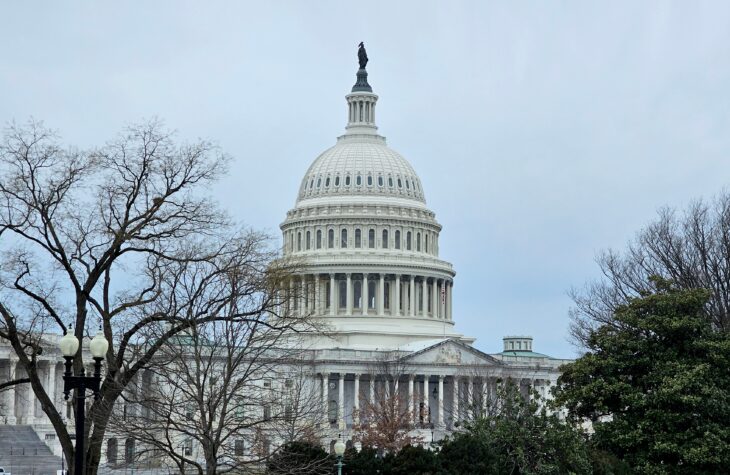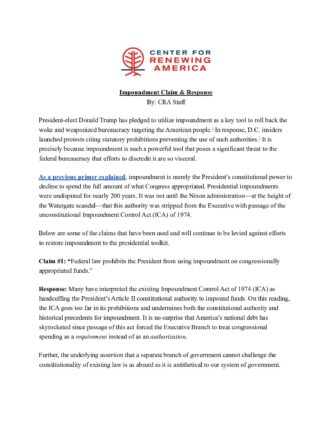
Impoundment Claim & Response

Impoundment is constitutional and enjoys a long history of usage. Further, the restoration of impoundment—and the inherent understanding that appropriations are permissive ceilings and not mandatory floors—diminishes partisan political warfare and returns the federal government back to a healthier era where tension was vested more in separate branches of government and less in partisan differences and the courts.
President-elect Donald Trump has pledged to utilize impoundment as a key tool to roll back the woke and weaponized bureaucracy targeting the American people.1 In response, D.C. insiders launched protests citing statutory prohibitions preventing the use of such authorities.2 It is precisely because impoundment is such a powerful tool that poses a significant threat to the federal bureaucracy that efforts to discredit it are so visceral.
As a previous primer explained, impoundment is merely the President’s constitutional power to decline to spend the full amount of what Congress appropriated. Presidential impoundments were undisputed for nearly 200 years. It was not until the Nixon administration—at the height of the Watergate scandal—that this authority was stripped from the Executive with passage of the unconstitutional Impoundment Control Act (ICA) of 1974.
Below are some of the claims that have been used and will continue to be levied against efforts to restore impoundment to the presidential toolkit.
Claim #1: “Federal law prohibits the President from using impoundment on congressionally appropriated funds.”
Response: Many have interpreted the existing Impoundment Control Act of 1974 (ICA) as handcuffing the President’s Article II constitutional authority to impound funds. On this reading, the ICA goes too far in its prohibitions and undermines both the constitutional authority and historical precedents for impoundment. It is no surprise that America’s national debt has skyrocketed since passage of this act forced the Executive Branch to treat congressional spending as a requirement instead of as an authorization.
Further, the underlying assertion that a separate branch of government cannot challenge the constitutionality of existing law is as absurd as it is antithetical to our system of government. Every branch has a duty to interpret and apply the Constitution.
Claim #2: “There is no tradition or deep-rooted history of the presidential impoundment power that is infringed upon by the Impoundment Control Act.”
Response: This is false. The ICA purports to divest the President of a power that has as impressive a historical pedigree as any—a power recognized by both Federalists and Jeffersonians alike. Prior to passage of the ICA, impoundment occurred routinely and frequently without protests from Congress. The current statutory restrictions only allow the President to impound funds through rescission requests that have to be approved by Congress.
For quite obvious reasons, this rarely happens, as this provision effectively gives Congress a front-end greenlight to spend as much money as it wants followed by a back-end fiscal veto over any attempt by the Executive Branch to restrain congressional profligacy. The ICA violates nearly every historical and constitutional precedent of impoundment, disrupting checks and balances between the Executive and Legislative Branch.
Claim #3: “Historically, Presidents have spent less money than Congress has appropriated because Congress granted them such authority.”
Response: This is false. While there are some occasions of impoundment where Congress explicitly stated in their statutory authorizations that such appropriations were a spending ceiling, the vast majority of historical cases of impoundment prior to passage of the ICA reflect the understanding in both the Legislative and Executive Branch that appropriations are inherently permissive and not mandatory. And Presidents have impounded funds even when they were appropriated using mandatory language.3
Claim #4: “The presidential power to impound congressional funds cannot be found in the text or structure of the Constitution.”
Response: The power of impoundment stems from the text, structure, and historical implementation of the Constitution. It stems from the Executive Vesting Clause, Take Care Clause, Commander in Chief Clause, foreign affairs power, the negative-phrasing of the Appropriations Clause, and unbroken historical practice from the Founding to the ICA’s enactment. In its current incarnation, the ICA serves to structurally impair checks and balances by deferring to a congressional supremacist view of the Constitution. Indeed, the ICA’s enforcement mechanism is itself unconstitutional—vesting executive power in the Comptroller General of the Government Accountability Office (GAO) within the Legislative Branch. The ICA tasks this legislative officer with the executive power to enforce the provisions of the statute as well as the power to sue to enforce the execution of the law—a clear constitutional violation that infuses executive authority in the Legislative Branch.4
Claim #5: “Attempts to utilize impoundment will trigger a separation of powers fight between the Executive and Legislative Branch.”
Response: Perhaps this is so. If this occurs, it will be a fight that is both necessary and long overdue. The statutory constraints put on impoundment during the Nixon administration also triggered a separation of powers fight. Such fights occur fairly often and are a hallmark of the Founders’ vision regarding the three branches of government. The difference is the statutory restrictions imposed by the ICA are an unconstitutional attempt to permanently neuter the ability to even have a healthy separation of powers dispute. In fact, before the ICA was enacted, there were many fights between the Congress and the Executive when the then President impounded funds and these disagreements were worked out in what Justice Scalia called “the hurly-burly, the give-and-take of the political process between the legislative and the executive.”5
Claim #6: “President Trump unlawfully impounded security assistance to Ukraine in 2019 and was forced to relinquish those funds.”
Response: This is false. Ukraine funding was paused during the first Trump administration—consistent with the statutory confines of the Impoundment Control Act—for policy review to consider the best use of those funds. Following review, those funds were released amounting to nothing more than a programmatic delay. The GAO rushed out a report during the first, politically motivated, lawfare impeachment proceedings that wrongly concluded that the President does not have the ability to pause funding to conduct policy reviews on the best way to expend such funding.
Further, the very same GAO claimed that the Biden administration did not violate the ICA when it used the same power to impound border wall funding.6 Incredibly, the GAO claimed that the border wall funding amounted to a mere “programmatic delay” as opposed to an illegal “stoppage of money.” This even though the Trump administration also initiated a programmatic delay to assess how to spend the Ukraine funding.
The juxtaposition between the two GAO opinions should give observers pause, as they reveal the agency’s obvious politicization, untethered to both substantive or legally correct interpretations. Most importantly, these two incidents convey the necessity for restoring impoundment instead of relying on unconstitutional statutory limitations that can be interpreted subjectively for partisan political benefit.
Bottom Line: Impoundment is constitutional and enjoys a long history of usage. Further, the restoration of impoundment—and the inherent understanding that appropriations are permissive ceilings and not mandatory floors—diminishes partisan political warfare and returns the federal government back to a healthier era where tension was vested more in separate branches of government and less in partisan differences and the courts.
Read More:
The President’s Constitutional Power of Impoundment
The History of Impoundments Before the Impoundment Control Act of 1974
Endnotes
1. Donald Trump (June 20, 2023). “Using Impoundment to Cut Waste, Stop Inflation, and Crush the Deep State,” Agenda47. https://www.donaldjtrump.com/agenda47/agenda47-using-impoundment-to-cut-waste-stop-inflation-and-crush-the-deep-state
2. Ford, W. and Hoagland, W. (July 13, 2024). “Trump and His Allies Are Completely Wrong About Impoundments,” The Hill. https://thehill.com/opinion/white-house/4768497-trump-and-his-allies-are-completely-wrong-about-impoundments/
3. Paoletta, M. and Shapiro, D. (September 10, 2024). “The President’s Constitutional Power of Impoundment,” Center for Renewing America. https://americarenewing.com/the-presidents-constitutional-power-of-impoundment/
4. Id.
5. Hearings on S. 2170 et al. before the Subcommittee on Intergovernmental Relations of the Senate Committee on Government Operations, 94th Cong., 1st Sess. 87 (1975).
6. Emma, C. (June 15, 2021). “GAO: Biden Didn’t Break the Law with Border Wall Pause,” Politico. https://www.politico.com/news/2021/06/15/gao-biden-border-wall-pause-494614




